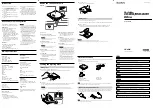
PSX-AR Manual Rev: P Software Rev: N
1
The PSX-AR Series
DCC Circuit Breaker & Auto Reverser
Integrated Turnout Control for Loop Automation
Intelligent, Solid State
Block Detection and Network Feed Back
Manual Rev P [10.17], Software Rev N [4.15]
*800.671.0641 [email protected]
*Designed by Larry Maier
*Developed by DCC Specialties
*US Patent 7,810,435
New Exclusive Digitrax Configuration
New Timing Delay Features
New Programmable Power Up Status
New Auto Stop
For DCC Use Only
The PSX-AR series is a product of years of research into problems dealing with false overloads that
cause premature shut down of DCC Boosters and other Circuit Breakers. These false overloads are
caused by large capacitors used in sound systems, decoders and lighted passenger cars. The
overload appears as a short circuit until the capacitors are charged. The logic on the PSX-AR Series
determines if the load is a true short or just an overload due to a discharged capacitor. A PSX-AR
also has the logic & power to control switch machines at the throat of a reversing loop.
PSX-AR Versions Available:
PSX-AR, PSX-ARFB [FeedBack], PSX-ARSC [SnapCoil] &
PSX-ARSCFB [Snapcoil with Feedback]
•
Automatic Coordination of Auto Reverse and Circuit Breaker Tasks:
The PSX-AR is both an
auto reverser and circuit breaker
•
Automates Reverse Loop Turnouts:
Integrated Stall Motor or Snap Coil Decoder,
automatically lines up switch machines when the polarity is reversed. Switch machine can
also be controlled with standard DCC Accessory Commands or push buttons.
•
All Solid State Operation:
Fast, solid state design, reliable quiet action, no clicks or sparks.
•
Adaptive Load Reset:
Electronically determines if the overload is a real short or due to excess
capacitance in sound decoders or lighted passenger cars.
•
Special Digitrax Configuration Jumper
: Optimize functionality with all Digitrax systems
•
Programmable timing delay:
Use the PSX-AR as a fast blow or an adjustable slow blow fuse
•
Auto Stop with DCC Reset:
A photocell can be connected a PSX-AR input. Normally, covering
the photocell will not cause any action. If the photocell is armed with a DCC command, the
PSX-AR will turn off the next time the photocell is covered. A DCC command can restore the
track power when desired.
•
Block Detection:
Either a photo cell or block current draw can be used to detect a train in a
block and to trigger a Block Occupied output. The current trigger level is programmable.
•
Over Voltage Protection:
The PSX-AR incorporates a voltage suppression diode that limits
voltage spikes on your layout.


































